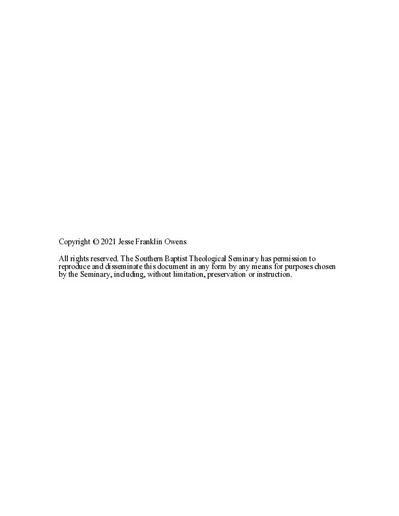| dc.description.abstract | The Salters’ Hall Controversy (1719) was a key event during a transitional period in English Dissent. The controversy has often been viewed as a demonstration of the theological decline of the General Baptists and Presbyterians. A careful consideration of the Salters’ Hall Controversy, however, reveals that the issue at hand for the Non- subscribers was not the doctrine of the Trinity, but the requirement of subscription. Consequently, a minister’s siding with the Non-subscribers at Salters’ Hall should not immediately be interpreted as opposition to the doctrine of the Trinity. Orthodox non-subscriptionism was a live option at Salters’ Hall.
Chapter 1 explores the history of research on the controversy, and introduces a taxonomy for considering the controversy. The taxonomy is drawn from John Walrond of Ottery’s 1731 assessment of Dissenters as being of three sorts: orthodox, heterodox, and a “middle sort.” Chapter 2 looks at the preludes to the Salters’ Hall Controversy within Dissent and the Church of England. Chapter 3 attempts to retell the story of Salters’ Hall, providing the details of the events, while also providing insight into the earliest interpretations of what the central issue of the controversy was, namely, subscription or the doctrine of the Trinity. Chapters 3, 4, and 5 employ Walrond’s taxonomy to explore the theological views of various ministers involved in the controversy. Chapter 3 focuses on the orthodox Subscribers, many of whom viewed the controversy as being about the doctrine of the Trinity. Chapter 5 looks at several of the Non-subscribers at Salters’ Hall who embraced heterodoxy either prior to or after 1719. Chapter 6 looks at some of the orthodox Non-subscribers who were orthodox on the doctrine of the Trinity, but opposed subscription at Salters’ Hall. The concept of “a middle sort” helps explain the large number of theologically orthodox Non-subscribers and is vital to a balanced interpretation of this important event. Chapter 7 aims at more fully interpreting the Salters’ Hall Controversy, focusing primarily on why the various groups either favored or opposed subscription there. | en_US |

